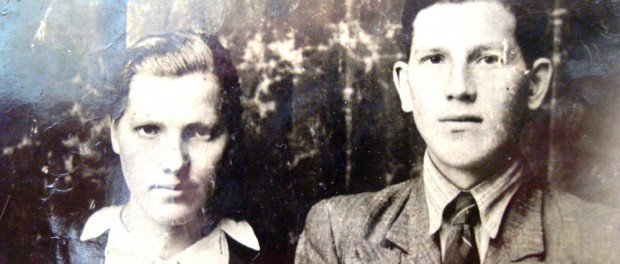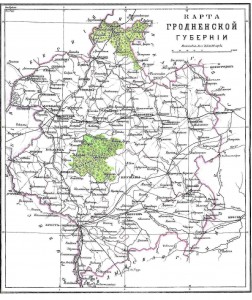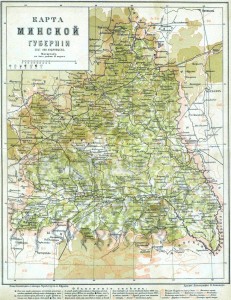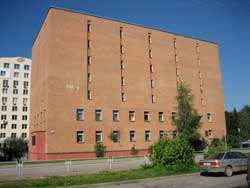Building the Belarusian family tree
More Belarusian families search for their ancestral roots
 Yanina and Zenon Bernatowicz. Photo via Bernatowicz family of Trukhany, Ashmyany District
Yanina and Zenon Bernatowicz. Photo via Bernatowicz family of Trukhany, Ashmyany District
Genealogy has become quite the fashion today in Belarus.
Indeed, if you wanted to hire an expert to help research information to compile your family tree, you have to book at least a year in advance. In the 1990s, the reading room of the National Historical Archives of Belarus had maybe 90 people a year, most of whom were interesting in academic research. Today, some 900 people from across the country might be busy chasing down their ancestry. Some people are lucky enough to find all the right information in a month. Others might have dedicated years to the search for their heritage. Others give up after only collecting a little data on a specific ancestor.
Belaruski Chas investigated where to go to find information about Belarusian family history, understanding that it takes time and money to accurately put together a family tree from scratch here in Eastern Europe’s Blue Eyed Country.

Grodno Guberniya in 1897, two decades before the fall of the Russian Empire. Art from Brochaus and Elton encyclopedia via Wikimedia Commons
Belarus Historical Archives – picking the right hunting ground
Belarus have two national archives where family data is available: the National Historical Archives of Belarus (“Natsionalny istorichesky arkhiv Belarusi”), which maintains documents related to the territory of the Russian Imperial guberniyas of Minsk, Vitebsk, and Mogilev (the former including the part of present Brest voblast eastward from Pinsk, the latter also covering much of present Homiel voblast), and the National Historical Archives of Belarus in Hrodna (“Natsionalny istorichesky arkhiv Belarusi v Hrodna”), which covers the historical Grodno guberniya, including uezd (district) territories of Brest, Kobrin, and Pruzhany in present-day Brest voblast.
It should be noted that some historical records documenting family history may also have settled in archives in Vilnius, Lithuania, and St. Petersburg, Russia. Indeed, in its northern capital, the Russian Federation also maintains the Foundation for the Senate Department Governing Heraldry (“Fond departamenta geroldy pravitelstvuyushego senata”), which keeps surviving documents on the history of all the noble families of the Tsarist Empire.

Brochaus and Elton map of the Minsk Guberniya. Polotsk Guberniya was to the northeast, and Mogilev Guberniya was to the east. Art by Nikolai Kudryatsev via Wikimedia Commons
“In the Soviet period, there wasn’t such an interest in family history,” said Dmitry Yatsevich, director of the National Historical Archives of Belarus in Minsk. “Many feared that they would find their heritage was not just from the proletariat. Such was the political situation that people did not dare to know their ancestry. Today, some will say with pride that they have Polish szlachta or Russian dvoryanin (nobility) roots.”
Of course, not everyone has 100 percent noble ancestry. Even in the days of the Russian Empire, no more than 6 percent of the population within present Belarus had been considered part of noble families. Indeed, under Russian rule, the difficulty Polish nobility faced when trying to obtain recognition and approval from authorities in the Russian Empire meant that many families lost their nobility status at the end of the Polish-Lithuanian Commonwealth (“Rzeczpospolita”). Indeed, with each successive major insurrection against Russia (the Kosciuszko Rebellion of 1794, the November Uprising of 1830, and the January Uprising of 1863), participating szlachta families were stripped of possessions and estates, and denied their nobility status. However, both successful and unsuccessful attempts to retain nobility produced procedural records that, if they somehow survived to today, can help in identifying Polish ancestries. Genealogical books, and the collections about the lives of Russian Imperial guberniya and uezd leaders, where they survive, can also be helpful.
“Unfortunately, a significant portion of these documents have been lost in the twentieth century,” said Yatsevich.
Still, for some families, the records do survive, and archive data can exist through the Russian Imperial period, extending back to the 18th century. There have even been cases where records from the 17th century was found in the Belarusian National Historical Archives. The chances that the data on an individual ancestor is complete (inclusive of information on birth, death, marriage, and other events) depend on many factors, including the place of residence, religion, and social status. For instance, if an individual belonged to the szlachta, and the archives have preserved the records on that person’s case for noble origin, then it is likely that paper trail extends farther back in time.
However, the location of where that person called home can mean quite a bit. For instance, documents from the Minsk guberniya were better preserved than those from Vitebsk guberniya. Belarus’ most problematic region is recognized as that of the former Mogilev guberniya (Mahiliou and Homiel voblasts), where data from many localities are today virtually absent. Here, even expert family researchers find the hunt to be very difficult. To make matters worse, in many areas of eastern Belarus, peasants in villages kept records without names.

The popularity of Belarus genealogy follows in the heels of many Western nations, where family historians have sought connections with popular historical figures for decades. Who do you think you are? is a popular TV series that traces the family trees of celebrities in the United Kingdom. Art via Wikimedia Commons
Do it yourself vs. waiting a year
There are two options for using the National Historical Archives: go look for documents yourself in the archives, or request an expert to do the compilation for you, for a fee.
The cost for family research done by an expert begins at about 2 million BYR (200 USD). This fee must be paid 6 working days in advance. However, depending on the complexity of the search, how much time the researcher must spend on the case, and the completeness of the information found, this amount can grow to 2-5 times this amount (400-1,000 USD). If the search results show nothing, or the information is very small, the original 2 million BYR will not be refunded, as there was at least some work done on the case.
Another consideration is that the results will not come back in the form of a family tree; instead of the standard tree form, consisting of squares with names and dates, you will get back just copies of what was found in the archives. The documents and links to resources will provide the data from which a tree may be put together.
This service has become very popular today, and not just with citizens of Belarus. There are many requests from families of people whose ancestors once lived here, but for various reasons have left. Requests come from countries of the European Union, from Russia, the United States, and even Australia. “On average, we do not do more than 100 genealogical research orders a year,” said Yatsevich. “Therefore, we have a queue for orders today that will keep us busy for the year ahead. The work is very time-consuming, and not fast. If all the documents are preserved, our archivists can find it in about two weeks, but sometimes searches can take a month. And only when data has been collected on one order can the specialist switch over to the next request.”
“This service that our experts provide is, in fact, unique, because no foreign archive will offer to do this,” he said. “Instead, other countries will help you find an agency specialized in genealogical support. However, from personal experience, I will say that it is more interesting to just go and work in the archive yourself.”
The emotions people feel when finding information about their own ancestors is incomparable to any excitement that one gets when receiving requested data from an archivist.

The National Historic Archives of Belarus in Minsk are located at Kropotkina St. 55, less than 200 meters north of Praspekt Masherava (Metro: Ploshcha Pieramohi, Trams 3, 4, 5, 10 to Teatralna stop, 9 minutes). Photo via National Historical Archives of Belarus
Using the reading room of the National Historical Archives
To work in the reading room of either National Historical Archive, there are no fees. All one needs to do is to make out any form of application to the director of the archive. In a day or two, the application will be considered, and if there are no objections, a sort of library card will be issued. With that, the search can begin.
Experts suggest that the time required to find all the information available about a given family in the archives will be anywhere from several months to several years. There are old-timers who have been coming back since the 1990s. That’s understandable. There are over 1 million documents kept in the archives; if you lined up all the bookshelves in one long row, their length would reach 11 kilometers (about the distance from the city center to the Minsk Sea recreational area north of the MKAD ring motorway).
To go to work in the archive, a family researcher should be prepared with all available information about their ancestors, including having the names dates, and places of births for all those who were born before 1917. If the eldest living relatives can provide this information, then a search of the archives will be of some use. Archive experts recommend starting along the paternal ancestry, as the maternal lineages are usually more difficult to hunt down. Naturally, knowing the married names of females won’t be enough; researchers will have to have the birth name of the women they are researching as well.
“You have to be prepared for difficulties when you come to the Archives,” said Yatsevich. “You have to even be ready for failure. For example, in one village the Catholic parish may have 200 years of complete documentation, but the Orthodox Church in the same village may not have saved any records at all. All documents might be handwritten manuscripts. However, sometimes these might not all be difficult to read; educated people of the time tried to write legibly. Some documents may be in Polish, earlier documents might even be in Latin. The reading room workers can, of course, give you advice, but they will not translate documents for you.”
To better navigate the archive, it is necessary to understand that there are several sources of genealogical information available in historic Belarus. There are parish registers of religious institutions, both Catholic and Orthodox, synagogues, census and population audit records, and conscription lists. If an individual worked on the railroad, there are inventory management documents. Provincial medical facilities might have records of medicines dispatched to patients. Educators may be found as being documented as managers of public schools, and so on.
“At the time that a new user comes to the archives, that person becomes a (family researcher),” said Yatsevich. “That person learns how to work with documents. We at one time substituted an elderly researcher with a younger one. There was a case where a 14-year-old wanted to join the archive’s reading room. Considering the value of the documents, we allow only adults to work there. However, we met with one of his relatives, and agreed to issue a library card to that person, through which the boy was able to come in and study.”
“Compiling a family tree is complicated, but very addictive,” the National Historical Archives director said. “The time spent in archives is such that some people might find enough information to write a book.”
Online resources for Belarusian family research
The historical archives in Minsk and Hrodna cover the period until 1917. To find information about relatives who were born after the Russian Revolution, family researchers will have to consult the National Archives of the Republic of Belarus, the voblast state archives, the voblast civil registry offices (ZAGS), and zonal state archives.
There is also a lot of assistance available for collecting data about relatives who died during the Great Patriotic War and Stalinist repressions, including Internet databases.
The General Database (“Obobshchenny bank dannykh” or OBD) Memorial website contains some 13.7 million digital copies of archived manuscripts involving those who were “irretrievably lost” (killed or missing in action). The documents include some 38,000 from the Central Archives of the Russian Defense Ministry (TsAMO), the Central Naval Archives (TsVMA), the Russian State War Archives (RGVA), State archives of the Russian Federation (GARF), and associated regional branches, along with 42,200 military passports documenting military burial in grounds located in the Russian Federation and abroad. There are also more than 1,000 Memorial Books added into the database. All records are in Russian, some of which are images that can’t be Google translated.
The database, set up to provide proof of the number of dead suffered by the Red Army during its war with Nazi Germany, lists 29 million records total on the site, providing primary source records of the 8.67 million who died in service to the Soviet Union (including such elements as the Red Army-organized People’s Army of Poland that took part in actions of the First Belorussian Front). Primary source record means documentation of an event recorded around the time that event (such as a death) took place. In the future, the database promises to be augmented with declassified records from other Russian/Soviet wars that took place in the 20th century.
“On the site, you can find information about the rank of the deceased, the unit in which he served, the date and caused of death (killed, died of wounds, missing, etc.) and the place of burial,” according to the website. Also included are specialties of the deceased, as well as the names and addresses of relatives who were sent death notices and the means by which the notices were sent (mail, oral instruction, etc.).
Additionally, the Memorial International Society, in collaboration with the Commissioner for Human Rights in the Russian Federation, the Russian United Democratic Party “Yabloko,” and the Likhachev Swiss Program for Development and Cooperation, developed a similar database of “Victims of Political Terror in the USSR”. Developed from the Fourth Edition CD of the names of those who died under Stalinist and other repressions during the era of the Soviet Union, the list contains more than 2.6 million names. Additional names were added from Memorial Books made for those who died on Sakhalin Island, and the third volume of the Memorial Book documenting those who died of repressions who were living in the Autonomous Republic of Crimea (a post-Soviet Ukrainian territory now claimed by Russia; most victims were Crimean Tatar), among others. The list contains dates and place of birth, residence, date of arrest, sentencing, and dates of rehabilitation, as well as the source organization of the data. The site is in Russian, but can be Google-translated.
For Jewish Genealogy, the main resource has been JewishGen’s Belarus Special Interest Group (SIG), which maintains a useful collection of resources. Most of these are geared toward those seeking their Jewish ancestry in the country, but quite a bit of the information can be of general interest to anyone hunting down their family history, no matter their ethnicity.
Verifying place names not found in the English, Russian, or Belarusian version of Wikipedia can be problematic, but Radzima has managed to capture many of the church, village, and manor names across the country.
Additionally, Polish sources of online information exist that cover Belarus, including the databases maintained by the Warsaw Genealogical Society (“Warszawskie Towarzystwo genealogiczne”) and private databases maintained by Marek Jerzy Minakowski, PhD, covering members of the Great Sejm of the Polish-Lithuanian Commonwealth, and about 400,000 famous Central and Eastern European personalities, including some from Belarus (the latter of which requires pre-payment). These sites are in Polish, but can be Google-translated.
Lithuanian archives also exist, but they are still in the early stages of development and, as would be expected, focus mostly on Lithuania. Still, the potential for items of interest to Belarusian family researchers remains quite high for what eventually might emerge from the country, given the frequency of border fluctuations even in just the past century.
More general English-language genealogical records sites that are free of charge include the Genealogy Indexer and FamilySearch.org, the latter of which is maintained by the US-based Church of Latter Day Saints (and is mostly useful for searching records of those who emigrated from the territory of Belarus to the United States more than 70 years ago).
Lastly, a number of shared online family trees also exist for putting together family trees from information gathered, though the reliability of existing profiles on these sites is dictated by the amount of research done by users. Among the most popular of these are Ancestry and MyHeritage. The latter of these two services maintains ownership of the freemium genealogical social-networking website Geni, which garnered fame early in its development by identifying the very distant family relationship between Democrat U.S. President Barrack Obama and former Republican Vice President Dick Cheney. Thanks to a concerted effort among certain Estonian users, it’s been claimed that one Estonian in six currently can use Geni to trace their ancestry.
Original story translated from Belaruski Chas
By Anna Tolkach

Do you have any information if Earth Day is celebrated in Belarus?